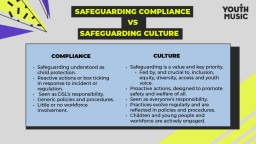Safeguarding culture and ways of working
Safeguarding is most effective when it is a culture and mindset. Rather than a “box-ticking” compliance exercise, safeguarding should be a continually evolving practice, part of the culture and DNA of an organisation. What’s more, it should be done with and for the people it’s designed to protect from harm.
This means:
- There’s a culture of “it could happen here” within your organisation. Everyone understands that safeguarding is their responsibility: promoting safety, understanding how to identify safeguarding concerns, and knowing what to do if there is a concern.
- Things are done pro-actively, in anticipation of what could happen. Like risk-assessing work before it begins and putting in place mitigations.
- There’s a culture of children and young people’s views being heard, listened to, and responded to. Children and young people feel confident to communicate what they need to feel safe, and in the response they would receive if they made a disclosure. The same goes for staff and volunteers.
- Dialogue and reflection on safeguarding practices takes place regularly with the staff and volunteer team. Formal training means people’s skills and knowledges stay up-to-date.
- Safeguarding policies and procedures not only meet the legal requirements for your organisation, but are regularly reviewed and updated to mirror your culture and ways of working.
- There’s an inclusive culture that recognises people’s different identities, contexts, needs and experiences to prevent different types of normalised harm and discrimination. Management and leadership approaches mean that people feel safe, valued and able to disclose concerns equitably.
Our article ‘Putting the Spotlight on Safeguarding’ has more insights on what safeguarding cultures look like.
Safeguarding culture vs safeguarding compliance
In developing a safeguarding culture, we can move away from “safeguarding compliance”. Safeguarding compliance is when safeguarding policies technically meet what’s required for an organisation, but these policies might be generic and irrelevant to their context. Or their workforce might not see safeguarding as their responsibility. The chart below summarises these two approaches:

If you apply for Youth Music funding, we’ll want to know that you’re developing a safeguarding culture and we ask for some examples that demonstrate how you’re doing this. The Developing a Safeguarding Culture resources shared in this hub can support you to get started or identify the next steps.
